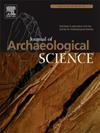从档案史学到3D建模:精确重建El Castillo洞穴旧石器时代景观,探索手模板分散的空间动态
IF 2.6
1区 地球科学
Q1 ANTHROPOLOGY
引用次数: 0
摘要
我们提出了一种全面的方法来重建El Castillo洞穴(Puente Viesgo, Cantabria)的史前状态,可以对其顶板图案的分布进行精确的空间分析。随着时间的推移,由于地质和人类活动的影响,洞穴经历了许多变化,这些变化改变了它的原始外观。为了了解旧石器时代社会如何利用空间创造岩石艺术,我们将不同类型的历史档案数据研究与现代扫描和3D建模技术相结合。我们开始进行实地数据收集和档案研究,包括历史照片、地图、挖掘记录、书面和口头资料,并辅以地貌分析,以评估洞穴的自然和人为变化。在第二阶段,使用3D建模软件,我们开发了一个三维模型,我们几乎删除了现代修改(例如楼梯和照明)并恢复了古代土壤水平,以重建可能出现在旧石器时代晚期的洞穴。本研究为利用地理信息系统对手印图案进行空间分析奠定了基础。这种方法在解释不同类型的空间方面提供了有希望的结果,表明它们是一个特别容易被大量观众访问的主题,因此使我们更接近史前人类行为和象征性实践的理解。本文章由计算机程序翻译,如有差异,请以英文原文为准。
From archival historiography to 3D modelling: An accurate reconstruction of the Palaeolithic landscape in El Castillo Cave to explore the spatial dynamics of hand stencil dispersion
We propose a comprehensive approach for the reconstruction of the prehistoric state of El Castillo Cave (Puente Viesgo, Cantabria) that allows a precise spatial analysis of the distribution of its parietal motifs.
The cave has undergone numerous changes over time due to both geological and anthropic processes, which have altered its original appearance. In the aim of understanding how Palaeolithic societies used the space for creating rock art, we combined the study of historical archival data of different types with modern scanning and 3D modelling techniques.
We began carrying out field data recollection, as well as archival research, including historical photographs, maps, excavation records and written and oral sources, supplemented by geomorphological analyses to assess natural and anthropic alterations of the cavity. In a second phase, using a 3D modelling software, we developed a three-dimensional model where we virtually removed modern modifications (e.g., staircases and lighting) and restored ancient soil levels, to reconstruct the cave as it likely appeared during the Upper Palaeolithic period. This work served as a basis for spatial analyses of the hand stencil motifs through Geographic Information Systems. This approach provides promising results in terms of interpretation of different types of space by suggesting they are a motif particularly easily accessible for a large viewership, therefore bringing us closer to the apprehension of prehistoric human behaviour and symbolic practices.
求助全文
通过发布文献求助,成功后即可免费获取论文全文。
去求助
来源期刊

Journal of Archaeological Science
地学-地球科学综合
CiteScore
6.10
自引率
7.10%
发文量
112
审稿时长
49 days
期刊介绍:
The Journal of Archaeological Science is aimed at archaeologists and scientists with particular interests in advancing the development and application of scientific techniques and methodologies to all areas of archaeology. This established monthly journal publishes focus articles, original research papers and major review articles, of wide archaeological significance. The journal provides an international forum for archaeologists and scientists from widely different scientific backgrounds who share a common interest in developing and applying scientific methods to inform major debates through improving the quality and reliability of scientific information derived from archaeological research.
 求助内容:
求助内容: 应助结果提醒方式:
应助结果提醒方式:


